
|
The brightness evolution has slowed down just before the perihelion passage. But now it is so bright as 6.2 mag (Sept. 18, Chris Wyatt). In the Southern Hemisphere, it is observable in the morning sky until mid September. Then it is observable in the evening sky from late September to mid October. In the Northern Hemisphere, it is not observable until late December when the comet will fade down to 13 mag.
Date(TT) R.A. (2000) Decl. Delta r Elong. m1 Best Time(A, h)
Sept.20 11 55.76 -32 51.9 0.508 0.650 34 5.2 19:25 ( 70,-32)
Sept.27 13 58.30 -30 10.4 0.687 0.626 38 5.7 19:14 ( 62,-12)
|

|
Appearing in the morning sky again. Now it is so bright as 7.1 mag (Sept. 17, Marco Goiato). It will be observable in good condition in the Southern Hemisphere after this. But it keeps low in the Northern Hemisphere.
Date(TT) R.A. (2000) Decl. Delta r Elong. m1 Best Time(A, h)
Sept.20 8 47.03 -2 55.5 1.571 1.124 45 6.9 4:21 (285, 16)
Sept.27 8 38.06 -7 49.8 1.431 1.169 53 6.9 4:27 (296, 21)
|
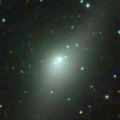
|
The brightness evolution has slowed down just before the perihelion passage. But now it is bright as 9.4 mag (Sept. 18, Chris Wyatt). It keeps observable in good condition until early November in the Southern Hemisphere. In the Northern Hemisphere, it is observable only in the evening low sky from late September to mid November. But it will be observable in excellent condition after 2015 January while the comet will be fading. It will pass extremely close to Mars on Oct. 19.
Date(TT) R.A. (2000) Decl. Delta r Elong. m1 Best Time(A, h)
Sept.20 18 14.92 -53 29.5 1.015 1.489 95 8.5 19:25 ( 10, 1)
Sept.27 17 54.48 -44 6.8 1.138 1.458 85 8.7 19:14 ( 19, 8)
|

|
It brightened up to 6.0 mag from July to August (July 24, Maik Meyer). Now it is fading. But it is bright as 8.7 mag still now (Sept. 19, Maik Meyer). It keeps observable in good condition until November in the Southern Hemisphere, or December in the Northern Hemisphere.
Date(TT) R.A. (2000) Decl. Delta r Elong. m1 Best Time(A, h)
Sept.20 19 22.36 20 43.8 0.964 1.627 111 9.1 19:25 ( 0, 75)
Sept.27 19 13.74 14 7.7 1.172 1.729 105 9.9 19:14 ( 16, 68)
|

|
It brightened rapidly in outburst in mid October in 2013. It will be fading gradually after this. But it is bright as 11.0 mag still now (Sept. 18, Chris Wyatt). In the Southern Hemisphere, it keeps observable in good condition for a long time until the comet fades out. In the Northern Hemisphere, it keeps extremely low after this.
Date(TT) R.A. (2000) Decl. Delta r Elong. m1 Best Time(A, h)
Sept.20 21 38.69 -51 29.8 2.414 3.077 122 11.4 21:42 ( 0, 4)
Sept.27 21 36.88 -51 17.4 2.549 3.144 117 11.6 21:12 ( 0, 4)
|

|
Now it is 14.7 mag (Aug. 29, iTelescope Observatory, Mayhill). In the Northern Hemisphere, it will be observable at 12-13 mag in excellent condition from 2014 summer to 2015 spring. In the Southern Hemisphere, it will locate low around the highlight.
Date(TT) R.A. (2000) Decl. Delta r Elong. m1 Best Time(A, h)
Sept.20 8 25.62 24 50.5 2.433 2.017 54 13.3 4:21 (263, 36)
Sept.27 8 42.91 24 17.8 2.370 2.010 57 13.2 4:27 (265, 39)
|
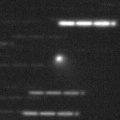
|
New bright comet. Now it is 12.9 mag and visible visually (Sept. 18, Chris Wyatt). It will approach to the earth in December and January, and it is expected to brighten up to 8 mag. In the Southern Hemisphere, it keeps observable in excellent condition until late January. In the Northern Hemisphere, it keeps extremely low until mid December. But after that, it will be observable in excellent condition.
Date(TT) R.A. (2000) Decl. Delta r Elong. m1 Best Time(A, h)
Sept.20 7 34.30 -41 41.5 2.390 2.279 71 14.0 4:21 (325, 1)
Sept.27 7 42.15 -41 54.2 2.285 2.205 72 13.7 4:27 (329, 3)
|

|
Now it is 13.9 mag (Aug. 29, iTelescope Observatory, Mayhill). It keeps observable for a long time after this while the comet will be fading gradually.
Date(TT) R.A. (2000) Decl. Delta r Elong. m1 Best Time(A, h)
Sept.20 8 24.11 11 49.9 2.452 1.992 51 13.7 4:21 (276, 29)
Sept.27 8 37.29 10 45.7 2.428 2.028 55 13.9 4:27 (281, 33)
|

|
No bright outburst was reported in July and August. It will be unobservable in mid September in the Northern Hemisphere, or in late October in the Southern Hemisphere.
Date(TT) R.A. (2000) Decl. Delta r Elong. m1 Best Time(A, h)
Sept.20 15 38.52 -27 41.1 6.511 6.110 62 14.0 19:25 ( 48, 8)
Sept.27 15 42.93 -27 46.0 6.603 6.108 56 14.0 19:14 ( 50, 6)
|

|
Now it is 12.8 mag (Aug. 19, Marco Goiato). It keeps bright as 13-14 mag for a long time from 2013 to 2014.
Date(TT) R.A. (2000) Decl. Delta r Elong. m1 Best Time(A, h)
Sept.20 20 27.62 -30 17.7 2.499 3.176 124 14.0 20:31 ( 0, 25)
Sept.27 20 28.50 -29 56.0 2.590 3.186 118 14.1 20:04 ( 0, 25)
|
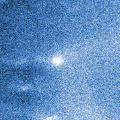
|
New bright comet. Now it is 14.5 mag (Sept. 6, C. Rinner, F. Kugel). It keeps 13-14 mag until 2015 spring. But it keeps locating low in the morning sky. In the Southern Hemisphere, it is too low to observe until December.
Date(TT) R.A. (2000) Decl. Delta r Elong. m1 Best Time(A, h)
Sept.20 9 15.30 16 58.7 2.243 1.620 40 14.4 4:21 (264, 22)
Sept.27 9 38.84 15 42.1 2.172 1.574 41 14.2 4:27 (267, 23)
|
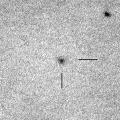
|
Now it is 14.2 mag (Aug. 28, Jakub Cerny). Getting brighter than originally expected, and it is already visible visually. It is expected to brighten up to 4 mag from autumn to winter in 2015. It is observable in good condition in the Southern Hemisphere until the highlight, or in the Northern Hemisphere after the highlight.
Date(TT) R.A. (2000) Decl. Delta r Elong. m1 Best Time(A, h)
Sept.20 23 13.64 -22 13.7 4.544 5.485 157 14.4 23:16 ( 0, 33)
Sept.27 23 6.66 -22 59.8 4.522 5.418 150 14.3 22:41 ( 0, 32)
|

|
Now it is 14.2 mag (Aug. 28, Jakub Cerny). It is observable at 14 mag in excellent condition until November.
Date(TT) R.A. (2000) Decl. Delta r Elong. m1 Best Time(A, h)
Sept.20 23 54.34 -5 11.6 1.314 2.317 175 14.6 0:01 ( 0, 50)
Sept.27 23 51.62 -5 48.3 1.340 2.335 170 14.7 23:26 ( 0, 49)
|

|
Now it is 13.6 mag (Aug. 27, Sandor Szabo). It keeps bright at 13-14 mag for a long time until 2014.
Date(TT) R.A. (2000) Decl. Delta r Elong. m1 Best Time(A, h)
Sept.20 18 22.01 -7 53.7 6.594 6.816 98 14.6 19:25 ( 21, 45)
Sept.27 18 20.75 -8 36.3 6.738 6.840 91 14.7 19:14 ( 27, 43)
|

|
Now it is 14.2 mag (Aug. 27, Jakub Cerny). It keeps 13-14 mag and observable in good condition in the Northern Hemisphere for a long time from 2013 to 2014. It locates low in the Southern Hemisphere. The split fragment of 18 mag was observed on Aug. 27 (F. Manzini, V. Oldani, A. Dan, R. Crippa, R. Behrend), and it keeps visible at 19.5 mag still on Sept. 7 (G. Masi, P. L. Catalano, U. Masi).
Date(TT) R.A. (2000) Decl. Delta r Elong. m1 Best Time(A, h)
Sept.20 23 30.87 46 56.0 3.488 4.223 131 14.6 23:32 (180, 78)
Sept.27 23 19.41 44 52.8 3.491 4.259 134 14.6 22:54 (180, 80)
|
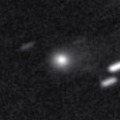
|
Now it is 14.9 mag (Aug. 12, Taras Prystavski). It is expected to brighten up to 13 mag and to be observable in good condition in 2015. It will be unobservable temporarily after mid September.
Date(TT) R.A. (2000) Decl. Delta r Elong. m1 Best Time(A, h)
Sept.20 14 35.75 -6 5.8 4.588 3.907 42 14.7 19:25 ( 74, 12)
Sept.27 14 43.75 -6 47.0 4.620 3.878 37 14.7 19:14 ( 75, 9)
|

|
Big asteroid discovered in 1906. It suddenly showed the cometary activity on Dec. 11, 2010, probably due to an impact of a small object. It has already turned to be stellar.
Date(TT) R.A. (2000) Decl. Delta r Elong. m1 Best Time(A, h)
Sept.20 4 56.56 18 59.6 3.052 3.401 101 14.9 4:21 (327, 72)
Sept.27 4 58.24 19 12.2 2.954 3.403 108 14.8 4:27 (352, 74)
|

|
Now it is 14.9 mag (Aug. 6, Ken-ichi Kadota). It keeps 15 mag for a long time from 2014 to 2015. It is observable in excellent condition in 2014 in the Southern Hemisphere, or in 2015 in the Northern Hemisphere.
Date(TT) R.A. (2000) Decl. Delta r Elong. m1 Best Time(A, h)
Sept.20 1 21.87 -36 5.4 3.360 4.170 138 14.8 1:28 ( 0, 19)
Sept.27 1 13.70 -35 46.8 3.329 4.149 140 14.8 0:53 ( 0, 19)
|

|
It brightened up to 11-12 mag in 2012. Now it is 14.9 mag (Aug. 12, Taras Prystavski). Now it is not observable. It will be observable at 15 mag in good condition again in 2015.
Date(TT) R.A. (2000) Decl. Delta r Elong. m1 Best Time(A, h)
Sept.20 11 59.00 -7 44.5 9.202 8.213 9 15.0 19:25 ( 95,-21)
Sept.27 12 0.61 -7 58.7 9.242 8.249 7 15.1 4:27 (266,-19)
|
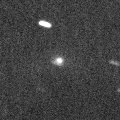
|
Now it is 15.3 mag (Sept. 1, Catalina Sky Survey). It will be observable at 14.5 mag in excellent condition from October to December.
Date(TT) R.A. (2000) Decl. Delta r Elong. m1 Best Time(A, h)
Sept.20 4 39.89 16 18.8 1.160 1.731 105 15.3 4:21 (342, 71)
Sept.27 4 51.45 17 40.8 1.099 1.721 109 15.1 4:27 (358, 73)
|
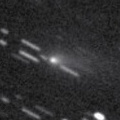
|
It brightened up to 2 mag by unusual major outburst in 2007. It is coming back now. Now it is 14.4 mag (Aug. 28, Jakub Cerny). In the Northern Hemisphere, it keeps observable until it fades out in 2015. In the Southern Hemisphere, it keeps extremely low after this.
Date(TT) R.A. (2000) Decl. Delta r Elong. m1 Best Time(A, h)
Sept.20 5 1.23 45 8.7 2.114 2.453 97 15.3 4:21 (217, 77)
Sept.27 5 7.11 46 8.1 2.063 2.480 102 15.4 4:27 (196, 78)
|

|
It passed only 0.4 A.U. from the earth, and 0.8 A.U. from the sun in November and December in 2013, and brightened up to 4.7 mag (Nov. 28, Juan Jose Gonzalez). Now it is 16.2 mag (Aug. 12, Taras Prystavski). It keeps observable until early September in the Northern Hemisphere, or early November in the Southern Hemisphere.
Date(TT) R.A. (2000) Decl. Delta r Elong. m1 Best Time(A, h)
Sept.20 15 53.31 -31 40.1 4.242 3.953 66 15.4 19:25 ( 42, 7)
Sept.27 15 58.45 -32 7.1 4.416 4.029 61 15.6 19:14 ( 44, 5)
|

|
It brightened very rapidly, and brightened up to 9.4 mag in early July (July 4, Maik Meyer). However, it will be fading rapidly after this. It has already faded down to 11.9 mag (Aug. 27, Uwe Pilz), and 14.5 mag (Aug. 28, Jakub Cerny). It keeps observable until early September in the Southern Hemisphere, or until late September in the Northern Hemisphere.
Date(TT) R.A. (2000) Decl. Delta r Elong. m1 Best Time(A, h)
Sept.20 14 0.66 12 26.5 2.332 1.611 34 15.4 19:25 ( 95, 15)
Sept.27 14 2.52 11 44.0 2.478 1.688 30 15.8 19:14 ( 96, 12)
|

|
New comet. Now it is 16.0 mag (Aug. 23, J. Hambsch, E. Bryssinck). It will brighten up to 14.5 mag in November. In the Northern Hemisphere, it keeps observable in good condition until the comet will fade out in next spring. In the Southern Hemisphere, it will be unobservable in late September.
Date(TT) R.A. (2000) Decl. Delta r Elong. m1 Best Time(A, h)
Sept.20 6 32.43 34 59.7 1.706 1.826 80 15.8 4:21 (260, 62)
Sept.27 6 42.92 40 4.6 1.566 1.788 85 15.5 4:27 (249, 67)
|
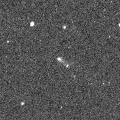
|
Now it is 14.2 mag (Aug. 28, Jakub Cerny). First return of a new periodic comet which brightened up to 13 mag in 2007. It was expected to brighten up to 13 mag again and observable in good condition from summer to autumn in 2014. But actually, it is fainter than expected.
Date(TT) R.A. (2000) Decl. Delta r Elong. m1 Best Time(A, h)
Sept.20 23 36.05 -13 30.1 1.302 2.293 167 15.6 23:38 ( 0, 41)
Sept.27 23 32.77 -14 28.7 1.324 2.296 161 15.6 23:08 ( 0, 41)
|

|
New comet. Now it is 15.7 mag (Sept. 15, Hidetaka Sato). It keeps 15 mag from autumn to winter. It moves southwards fast in winter.
Date(TT) R.A. (2000) Decl. Delta r Elong. m1 Best Time(A, h)
Sept.20 7 59.29 30 40.7 2.103 1.849 61 15.8 4:21 (259, 43)
Sept.27 8 14.14 27 55.5 2.027 1.831 64 15.7 4:27 (264, 46)
|
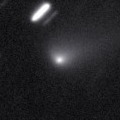
|
It brightened up to 12-13 mag from April to May. Now it is fading. It has already faded down to 15.2 mag (Aug. 12, Taras Prystavski). It will be unobservable in late October.
Date(TT) R.A. (2000) Decl. Delta r Elong. m1 Best Time(A, h)
Sept.20 15 41.99 -16 29.1 3.110 2.755 60 15.8 19:25 ( 55, 17)
Sept.27 15 53.43 -17 5.5 3.203 2.775 56 15.9 19:14 ( 55, 16)
|
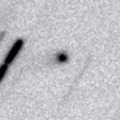
|
Now it is 16.1 mag (July 30, Taras Prystavski). It is expected to brighten up to 14 mag from 2015 to 2016. It is observable in good condition in the Southern Hemisphere. It locates somewhat low in the Northern Hemisphere.
Date(TT) R.A. (2000) Decl. Delta r Elong. m1 Best Time(A, h)
Sept.20 5 29.93 -21 57.1 4.906 5.088 94 16.0 4:21 (340, 30)
Sept.27 5 26.35 -22 33.9 4.780 5.056 100 15.9 4:27 (350, 32)
|
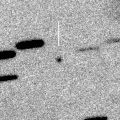
|
It keeps 14-15 mag for a long time from 2014 autumn to 2015 autumn. In the Southern Hemisphere, it keeps observable in excellent condition for a long time. In the Northern Hemisphere, it is only observable in the low sky from September to October. Then it will be unobservable until 2015 June.
Date(TT) R.A. (2000) Decl. Delta r Elong. m1 Best Time(A, h)
Sept.20 9 10.14 -22 23.5 3.369 2.755 45 16.2 4:21 (297, 0)
Sept.27 9 13.68 -24 49.5 3.248 2.702 49 16.1 4:27 (304, 3)
|
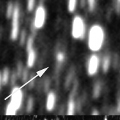
|
Now it is 16.2 mag (Aug. 24, Jean-Francois Viens). Distant object, but it keeps observable at 14 mag for a long time from 2015 to 2016.
Date(TT) R.A. (2000) Decl. Delta r Elong. m1 Best Time(A, h)
Sept.20 18 53.24 -5 7.0 6.171 6.525 106 16.1 19:25 ( 11, 49)
Sept.27 18 54.25 -5 28.4 6.244 6.494 100 16.1 19:14 ( 17, 48)
|
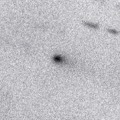
|
It brightened up to 14.6 mag in summer (July 8, Hidetaka Sato). Now it is fading. It has already faded down to 17.2 mag (Sept. 15, Hidetaka Sato). The condition is good in the Northern Hemispehre. It keeps observable until next February when the comet will be fainter than 18 mag. It locates somewhat low in the Southern Hemisphere.
Date(TT) R.A. (2000) Decl. Delta r Elong. m1 Best Time(A, h)
Sept.20 7 30.55 17 57.8 1.991 1.817 65 16.3 4:21 (279, 44)
Sept.27 7 43.74 17 21.2 1.964 1.857 68 16.4 4:27 (283, 47)
|
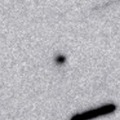
|
Now it is 16.9 mag (July 30, Taras Prystavski). It keeps observable at 15-16 mag for a long time from 2015 to 2016. In the Northern Hemisphere, it is observable in excellent condition. It locates somewhat low in the Southern Hemisphere.
Date(TT) R.A. (2000) Decl. Delta r Elong. m1 Best Time(A, h)
Sept.20 4 10.06 20 11.9 5.465 5.922 112 16.4 4:16 ( 0, 75)
Sept.27 4 8.39 20 46.3 5.338 5.897 119 16.3 3:47 ( 0, 76)
|
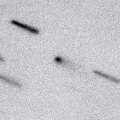
|
Now it is 15.8 mag (July 20, Toshiyuki Takahashi). In the Northern Hemisphere, it will be getting higher gradually after this, and keeps observable in good condition while the comet will be fading gradually. In the Southern Hemisphere, it keeps extremely low.
Date(TT) R.A. (2000) Decl. Delta r Elong. m1 Best Time(A, h)
Sept.20 7 56.44 30 41.6 1.892 1.676 62 16.4 4:21 (259, 44)
Sept.27 8 15.88 31 6.3 1.868 1.705 64 16.6 4:27 (260, 47)
|
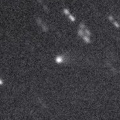
|
Now it is 15.7 mag (Sept. 1, Catalina Sky Survey). It will brighten up to 15 mag and will be observable in excellent condition from winter to spring.
Date(TT) R.A. (2000) Decl. Delta r Elong. m1 Best Time(A, h)
Sept.20 22 40.14 -20 23.2 0.896 1.855 154 16.8 22:42 ( 0, 35)
Sept.27 22 32.92 -20 24.5 0.881 1.807 147 16.6 22:08 ( 0, 35)
|

|
Now it is 17.4 mag (Aug. 5, A. Klotz, F. Kugel, C. Rinner, J. Nicolas). It will brighten up to 15 mag and will be observable in excellent condition from November to February in the Northern Hemisphere. It locates somewhat low in the Southern Hemisphere.
Date(TT) R.A. (2000) Decl. Delta r Elong. m1 Best Time(A, h)
Sept.20 6 18.57 30 42.5 2.456 2.534 82 16.8 4:21 (271, 64)
Sept.27 6 28.36 30 32.8 2.362 2.525 87 16.6 4:27 (275, 69)
|

|
It brightened up to 12-13 mag from 2012 to 2013. Now it is fading. But it is bright as 15.3 mag still now (Aug. 31, Toshiyuki Takahashi). It keeps 16-17 mag until autumn, and will be observable in good condition.
Date(TT) R.A. (2000) Decl. Delta r Elong. m1 Best Time(A, h)
Sept.20 0 44.94 -17 40.7 3.065 4.016 158 16.7 0:51 ( 0, 37)
Sept.27 0 40.33 -18 5.6 3.079 4.033 159 16.7 0:19 ( 0, 37)
|

|
New comet. It will approach to the sun down to 0.3 a.u. in 2015 July, and it is expected to be bright. Now it is 16.6 mag (Sept. 12, K. Hills). It keeps observable while the comet will be brightening gradually until January when the comet will be 15 mag. The condition is bad after that and it will be hard to observe. But in the Southern Hemisphere, it will be observable after mid July in 2015, and keeps observable while the comet will be fading gradually. In the Northern Hemisphere, it is extremely hard to observe after 2015.
Date(TT) R.A. (2000) Decl. Delta r Elong. m1 Best Time(A, h)
Sept.20 23 40.79 -29 17.6 3.588 4.499 151 16.8 23:43 ( 0, 26)
Sept.27 23 33.31 -29 41.1 3.543 4.421 147 16.7 23:08 ( 0, 25)
|
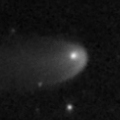
|
Now it is between 15.6 mag (July 7, Taras Prystavski) and 18.2 mag (July 3, K. Hills). It brightened up to 13 mag from 2011 to 2012. It will be fading after this, but it keeps brighter than 18 mag until 2015 spring.
Date(TT) R.A. (2000) Decl. Delta r Elong. m1 Best Time(A, h)
Sept.20 3 53.77 -4 40.7 8.301 8.826 118 16.9 4:00 ( 0, 50)
Sept.27 3 51.93 -4 44.9 8.247 8.861 125 16.9 3:30 ( 0, 50)
|
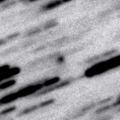
|
Now it is 17.5 mag (June 21, Hidetaka Sato). It will keep 16-17 mag for a long time from 2014 summer to early 2016. It keeps observable in excellent condition until autumn in the Southern Hemisphere. It keeps low in the Northern Hemisphere.
Date(TT) R.A. (2000) Decl. Delta r Elong. m1 Best Time(A, h)
Sept.20 17 12.28 -23 25.9 2.455 2.525 82 17.0 19:25 ( 32, 24)
Sept.27 17 21.26 -23 22.5 2.516 2.499 77 17.0 19:14 ( 34, 23)
|

|
Now it is 16.8 mag (Aug. 12, Taras Prystavski). It keeps 17 mag for a long time from 2014 to 2015. It is observable in excellent condition in the Northern Hemisphere. It is observable only until mid September in the Southern Hemisphere.
Date(TT) R.A. (2000) Decl. Delta r Elong. m1 Best Time(A, h)
Sept.20 16 7.84 31 6.0 4.146 3.884 68 17.0 19:25 ( 98, 50)
Sept.27 16 15.16 30 36.4 4.179 3.876 65 17.0 19:14 ( 99, 48)
|

|
Now it is 17.1 mag (Aug. 30, iTelescope Observatory, Mayhill). It keeps observable at 17-18 mag from August to November in excellent condition in the Northern Hemisphere. It locates somewhat low in the Southern Hemisphere.
Date(TT) R.A. (2000) Decl. Delta r Elong. m1 Best Time(A, h)
Sept.20 6 21.57 22 43.8 1.147 1.412 81 17.0 4:21 (286, 60)
Sept.27 6 41.14 22 46.3 1.127 1.430 84 17.0 4:27 (289, 63)
|

|
It will brighten up to 16 mag in winter, and will be observable in excellent condition.
Date(TT) R.A. (2000) Decl. Delta r Elong. m1 Best Time(A, h)
Sept.20 7 50.45 17 28.6 4.491 4.091 60 17.1 4:21 (276, 39)
Sept.27 7 56.82 17 1.2 4.396 4.089 65 17.0 4:27 (281, 45)
|
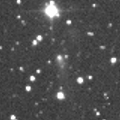
|
It brightened rapidly, and became brighter than originally predicted. Now it is 15.8 mag (Aug. 12, Taras Prystavski). It will be fading after this. It keeps observable until late September in the Northern Hemisphere, or early November in the Southern Hemisphere.
Date(TT) R.A. (2000) Decl. Delta r Elong. m1 Best Time(A, h)
Sept.20 16 10.58 -25 55.4 4.730 4.467 68 17.0 19:25 ( 43, 14)
Sept.27 16 16.63 -26 9.0 4.844 4.485 63 17.1 19:14 ( 45, 13)
|
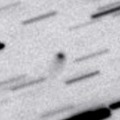
|
Now it is 17.6 mag (Aug. 19, Yasukazu Ikari). It keeps observable at 18 mag for a long time from 2013 to 2016. It keeps locating high in the Northern Hemisphere. It keeps locating very low in the Southern Hemipshere.
Date(TT) R.A. (2000) Decl. Delta r Elong. m1 Best Time(A, h)
Sept.20 16 47.42 46 13.7 6.589 6.467 78 17.2 19:25 (123, 59)
Sept.27 16 46.45 45 36.1 6.636 6.468 76 17.2 19:14 (121, 56)
|

|
Now it is 17.4 mag (Aug. 2, iTelescope Observatory, Siding Spring). It keeps observable at 17-18 mag from summer to winter in excellent condition in the Northern Hemisphere. It locates somewhat low in the Southern Hemisphere.
Date(TT) R.A. (2000) Decl. Delta r Elong. m1 Best Time(A, h)
Sept.20 6 31.68 18 10.3 2.258 2.294 79 17.2 4:21 (290, 55)
Sept.27 6 40.88 18 8.4 2.198 2.317 83 17.2 4:27 (297, 60)
|

|
It will brighten up to 16 mag and will be observable in excellent condition in winter. No observations have been reported since 2013 October.
Date(TT) R.A. (2000) Decl. Delta r Elong. m1 Best Time(A, h)
Sept.20 8 47.95 16 51.2 2.570 2.022 46 17.4 4:21 (268, 27)
Sept.27 9 3.99 16 0.1 2.511 2.016 49 17.3 4:27 (271, 30)
|

|
It will brighten up to 14 mag around the perihelion passage in 2019. In 2014, it will be observable in excellent condition at 17 mag from summer to winter in the Northern Hemisphere. It locates extremely low in the Southern Hemisphere. However, it is faint as 18.9 mag now, much fainter than this ephemeris (Aug. 5, Ken-ichi Kadota).
Date(TT) R.A. (2000) Decl. Delta r Elong. m1 Best Time(A, h)
Sept.20 3 26.08 35 13.0 12.004 12.499 117 17.4 3:32 (180, 90)
Sept.27 3 24.81 35 26.7 11.882 12.472 124 17.3 3:03 (180, 90)
|
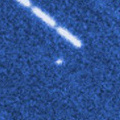
|
Now it is 19.7 mag (July 30, iTelescope Observatory, Siding Spring). It will brighten up to 9 mag in 2015 spring. But the condition of this apparition is bad. In the Southern Hemisphere, it keeps observable until winter when the comet will be 13 mag. But it is not observable around the brightest days. In the Northern Hemispehre, it keeps extremely low and hard to observe. It will be observable after 2015 autumn when the comet will fade out.
Date(TT) R.A. (2000) Decl. Delta r Elong. m1 Best Time(A, h)
Sept.20 20 18.25 -54 13.9 2.291 2.824 111 17.6 20:22 ( 0, 1)
Sept.27 20 15.88 -53 35.1 2.322 2.777 106 17.4 19:52 ( 0, 2)
|

|
Now it is 17.2 mag (Aug. 24, Jean-Francois Viens). It has brightened in outburst up to 14 mag twice, in 2006 January and 2011 May. It will pass the perihelion in 2015. It keeps observable at 17 mag for a long time after this.
Date(TT) R.A. (2000) Decl. Delta r Elong. m1 Best Time(A, h)
Sept.20 20 52.15 -14 36.9 5.159 5.908 134 17.4 20:55 ( 0, 40)
Sept.27 20 51.39 -14 45.4 5.238 5.902 127 17.5 20:27 ( 0, 40)
|
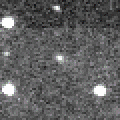
|
Now it is 17.9 mag (Aug. 5, Ken-ichi Kadota). It keeps observable at 17-18 mag in good condition from July to October.
Date(TT) R.A. (2000) Decl. Delta r Elong. m1 Best Time(A, h)
Sept.20 21 55.48 -14 43.4 1.579 2.495 149 17.5 21:58 ( 0, 40)
Sept.27 21 53.72 -14 23.7 1.623 2.491 142 17.5 21:29 ( 0, 41)
|

|
First return of a new periodic comet discovered in 2005. It was expected to be observable at 17 mag for a long time from 2013 to 2014. However, it has not been recovered yet. Actually, it is much fainter than predicted, fainter than 20.5 mag (Aug. 1, Jean-Francois Soulier).
Date(TT) R.A. (2000) Decl. Delta r Elong. m1 Best Time(A, h)
Sept.20 22 41.18 -13 8.0 2.448 3.407 159 17.6 22:44 ( 0, 42)
Sept.27 22 37.84 -13 35.0 2.500 3.418 151 17.7 22:13 ( 0, 41)
|

|
It keeps 17.5 mag and will be observable in excellent condition from autumn to winter in the Northern Hemisphere. It locates somewhat low in the Southern Hemisphere. However, it is actually 19.7 mag, much fainter than predicted (Sept. 3, Jean-Francois Soulier).
Date(TT) R.A. (2000) Decl. Delta r Elong. m1 Best Time(A, h)
Sept.20 6 37.59 23 19.5 1.428 1.568 78 17.7 4:21 (281, 57)
Sept.27 6 55.05 21 51.4 1.392 1.581 80 17.7 4:27 (287, 59)
|
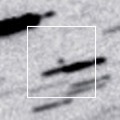
|
It will pass close to the earth from spring to summer in 2016, and it is expected to be observable at 6-7 mag in good condition. Now it is 18.3 mag (Aug. 25, K. Sarneczky). In the Northern Hemispehre, it keeps observable in good condition until 2015 spring when the comet will brighten up to 15.5 mag. In the Southern Hemisphere, it keeps low for a long time until 2016 spring.
Date(TT) R.A. (2000) Decl. Delta r Elong. m1 Best Time(A, h)
Sept.20 7 1.32 32 34.3 6.801 6.594 73 17.9 4:21 (262, 56)
Sept.27 7 1.64 32 48.1 6.622 6.534 80 17.8 4:27 (265, 62)
|

|
Now it is 18.2 mag (Aug. 4, L. Arnold). It will be observable at 17.5 mag in excellent condition from autumn to winter.
Date(TT) R.A. (2000) Decl. Delta r Elong. m1 Best Time(A, h)
Sept.20 1 47.16 16 12.5 1.600 2.496 145 18.0 1:53 ( 0, 71)
Sept.27 1 45.79 16 9.0 1.541 2.476 152 17.9 1:25 ( 0, 71)
|

|
First return of a new periodic comet discovered in 2004. It will be observable in excellent condition from autumn to winter. It is expected to brighten very rapidly, and brighten up to 16 mag from November to December.
Date(TT) R.A. (2000) Decl. Delta r Elong. m1 Best Time(A, h)
Sept.20 21 5.21 11 26.1 0.685 1.579 137 18.3 21:08 ( 0, 66)
Sept.27 21 6.77 10 42.6 0.676 1.544 132 17.9 20:42 ( 0, 66)
|

|
It was observed at 17.5 mag in early 2013. It was predicted to be observable at 17.5 mag again from spring to summer in 2014. But actually, it is 20.6 mag (June 21, Hidetaka Sato), much fainter than predicted by 3 mag.
Date(TT) R.A. (2000) Decl. Delta r Elong. m1 Best Time(A, h)
Sept.20 19 10.69 -20 30.1 2.738 3.219 109 22.5 19:25 ( 3, 34)
Sept.27 19 14.52 -20 45.1 2.855 3.243 103 22.6 19:14 ( 7, 34)
|
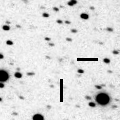
|
It was discovered in 1819, and re-discovered in 2003. Although it was predicted to be extremely faint as 26 mag, it unusually brightened up to 17.5 mag in outburst in 2013 July (July 6, Hidetaka Sato). However, no observations have been reported since mid July. It will pass the perihelion in 2014 August, and will approach to the sun down to 0.96 a.u. The brightness is predicted to be 23 mag at best. However, if the cometary activity continues, it may be observed brighter. Ken-ichi Kadota reported it was not detected, fainter than 16.3 mag, on May 21.
Date(TT) R.A. (2000) Decl. Delta r Elong. m1 Best Time(A, h)
Sept.20 9 42.26 16 11.6 1.671 1.015 34 23.1 4:21 (261, 16)
Sept.27 10 9.54 14 13.9 1.713 1.052 34 23.2 4:27 (264, 16)
|
|
![]()
 134P/Kowal-Vavrova
134P/Kowal-Vavrova C/2014 A4 ( SONEAR )
C/2014 A4 ( SONEAR ) C/2014 AA52 ( Catalina )
C/2014 AA52 ( Catalina ) C/2011 KP36 ( Spacewatch )
C/2011 KP36 ( Spacewatch ) 16P/Brooks 2
16P/Brooks 2 C/2013 V4 ( Catalina )
C/2013 V4 ( Catalina ) 106P/Schuster
106P/Schuster 201P/LONEOS
201P/LONEOS 110P/Hartley 3
110P/Hartley 3 246P/2010 V2 ( NEAT )
246P/2010 V2 ( NEAT ) C/2014 Q1 ( PanSTARRS )
C/2014 Q1 ( PanSTARRS ) C/2009 F4 ( McNaught )
C/2009 F4 ( McNaught ) 44P/Reinmuth 2
44P/Reinmuth 2 C/2013 G3 ( PanSTARRS )
C/2013 G3 ( PanSTARRS ) 304P/2014 L4 ( Ory )
304P/2014 L4 ( Ory ) 269P/2012 R2 ( Jedicke )
269P/2012 R2 ( Jedicke ) P/2012 B1 ( PanSTARRS )
P/2012 B1 ( PanSTARRS ) C/2012 K8 ( Lemmon )
C/2012 K8 ( Lemmon ) 191P/McNaught
191P/McNaught 70P/Kojima
70P/Kojima C/2010 U3 ( Boattini )
C/2010 U3 ( Boattini ) 19P/Borrelly
19P/Borrelly 174P/(60558) 2000 EC98 ( Echeclus )
174P/(60558) 2000 EC98 ( Echeclus ) 303P/2014 L1 ( NEAT )
303P/2014 L1 ( NEAT ) P/2005 L1 ( McNaught )
P/2005 L1 ( McNaught ) 11P/Tempel-Swift-LINEAR
11P/Tempel-Swift-LINEAR C/2013 X1 ( PanSTARRS )
C/2013 X1 ( PanSTARRS ) P/2014 M4 ( PanSTARRS )
P/2014 M4 ( PanSTARRS ) 305P/2014 N1 ( Skiff )
305P/2014 N1 ( Skiff ) 280P/2013 C1 ( Larsen )
280P/2013 C1 ( Larsen ) 289P/Blanpain
289P/Blanpain![]()


















































